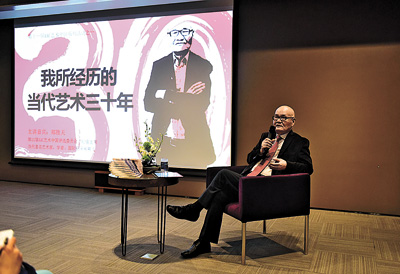Debra Li debra_lidan@163.com IN contrast to the beliefs of many Western scholars who claim that contemporary Chinese art arose in the late 1970s after the young generation came to embrace the art of influential figures such as Ralph Rosenborg and Andy Warhol, Zheng Shengtian believes that contemporary art took root in China in the 1920s and 1930s. While Warhol visited Beijing in 1982, Chinese masters like Lin Fengmian traveled to Europe and began experimenting with contemporary forms of art nearly a century ago. Sunday afternoon, some 200 art fans attended a lecture by Zheng at Artron Art Center in Nanshan District. Zheng is a veteran art scholar, head of jury for this year’s Art China Award and director of Asian exhibitions at Vancouver Art Gallery. “Although figures like Lin and Wu Dayu were marginalized in the 1950s when mainstream Chinese art then leaned towards realism under the influence of Russia, these artists continued working on their own,” Zheng said. Between 1961 and 1964, several exhibitions featuring Lin’s works were held in Beijing, Shanghai and Hong Kong. The Cultural Revolution brought a standstill to contemporary art, but the influence of previous masters never died down. In 1979, led by then vice president of Central Academy of Art and Craft (now Academy of Arts & Design, Tsinghua University) Zhang Ding, the murals painted on the walls of then newly built Beijing airport included works of various styles and tastes. The exhibition held in Beihai Park, Beijing in November 1979 featuring 23 young artists and the founding of The Stars, a society of young contemporary artists in the following summer, became significant events in Chinese art history. More than 200,000 visited The Stars’ exhibition held in the National Art Museum of China between August and September 1980. In 1986, art exhibition “Beyond the Open Door” featuring contemporary Chinese paintings was introduced to American audiences for the first time at the Pacific Asia Museum in Pasadena, California. A second exhibition arrived in 1991, showing Xu Bing’s “Book From the Sky” and “The Second” by Geng Jianyi. 
The number of contemporary artists grew quickly in this period and then in 1989, an incident drew world attention to contemporary art in China. Young artist Xiao Lu shot her own installation “Dialog” at the China Avant Garde Exhibition with a pellet gun. The first modern gallery opened in Shanghai in June 1989 and the first art expo was held in Guangzhou in 1992. “Many Chinese artists have exhibited abroad and gradually gained international fame over the years,” Zheng recalled. In 1999, Cai Guoqiang’s “Venice’s Rent Collection Courtyard” was exhibited at the 1999 Venice Biennale, where it won the Golden Lion. “We had a seminar in Venice discussing the Shanghai Biennale to be held the next year,” Zheng said. The previous Shanghai Biennale, held in 1998, featured ink paintings heavily. “Then we decided that the 2000 biennale would encourage curators and artists from overseas to participate and would not restrict the media of the exhibits.” Shimizu Toshio and Hou Hanru were picked as curators for the event, a true contemporary art biennale in China for the first time. For those who think contemporary art is hard to appreciate, Zheng said they have to actually walk into a gallery to observe. “In fact, contemporary art is closer to modern life and therefore can resonate with today’s audiences more easily,” he said. “Unlike classical works which are several hundred years away from us, contemporary works discuss topics we can relate to and are concerned about. A good contemporary artist should not be difficult to understand.” He gave the example of Song Dong’s “Waste Not,” an installation where the artist publicly arrayed all the contents of his mother’s former home. “Full of his generation’s childhood memories, the work easily resonates with Chinese audiences who grew up during and soon after the Cultural Revolution.” First exhibited in Beijing in 2005, the work has since traveled around the world to major galleries in Canada, the United Kingdom and the United States, where it has been well received by critics. Zheng also said that contemporary art is not the adversary of traditional Chinese art. “Many contemporary artists have drawn inspiration from tradition and find their voices in the dialogue between the present and the past. Reworking traditional aesthetics in conceptual ways, they use new forms and media — such as digital animations and site-specific installations — to provide a myriad of means to understand and examine tradition’s influence on visual culture in present-day China.” For instance, one series by Xu Bing used dry plants, paper, plastic woven bags, semitransparent glass and light to mimic traditional Chinese ink paintings. “Chinese contemporary art has been booming since its value was recognized in 2005, but market value is not everything. There is still a long way to go for artists, critics and audiences.” For those who want to attend the Basel Art Fair in Hong Kong, Zheng recommended they do some homework online to find out about the galleries they are interested in and mark them out on the fair’s site map the moment they walk in. | 
